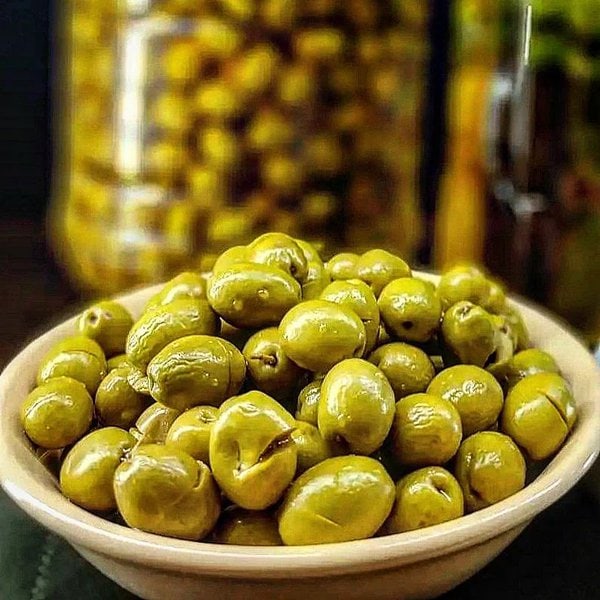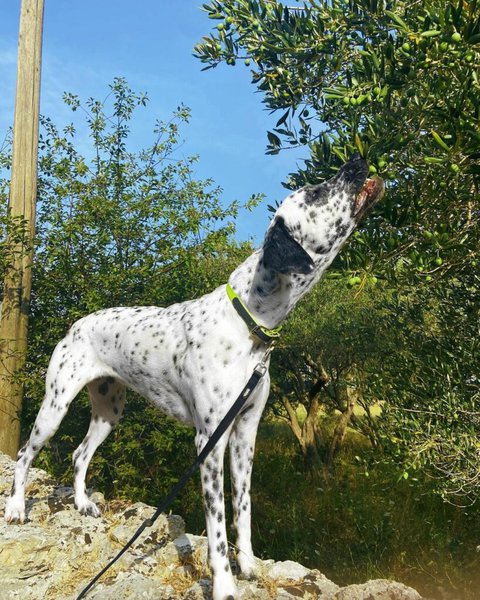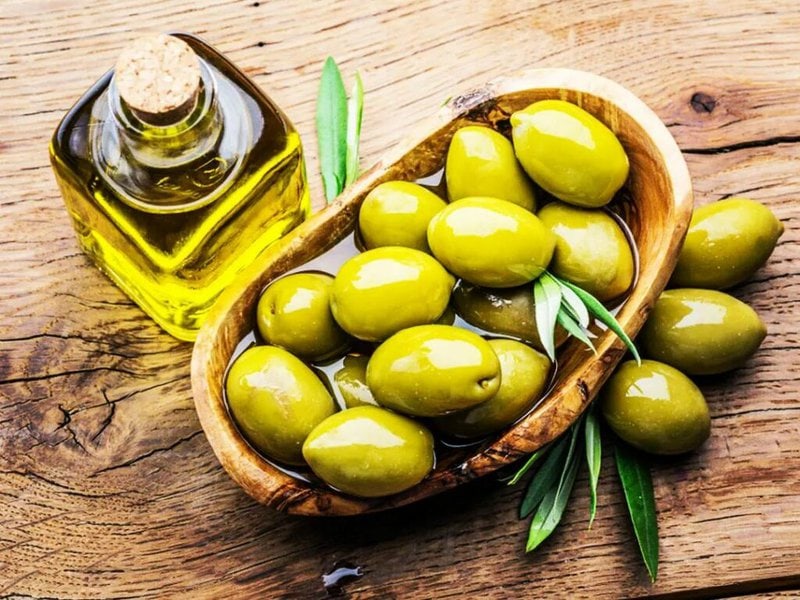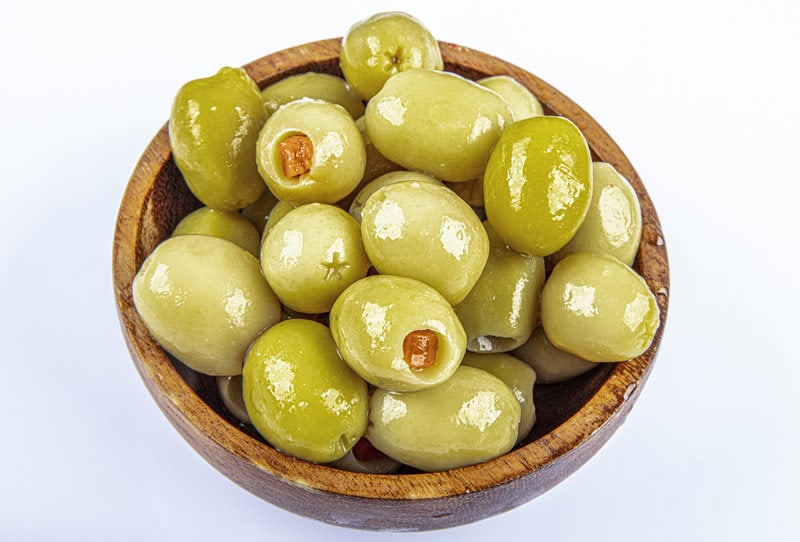Green olives are naturally bitter, but we just can’t get enough of this stone fruit because they pack several nutrients that are essential to our health. As someone who cares for your furry friend, you may wonder if your pet can eat olives since you enjoy and benefit from them. But can dogs eat green olives?
Yes, dogs can eat green olives only in moderation and without added seasonings. Green olives benefit dogs by boosting their immune systems, improving their skin and coat conditions, and preventing the loss of cognitive abilities as they age. Always avoid feeding pickled green olives to dogs due to their high salt content, resulting in sodium poisoning and other health complications.
You may wonder how best to feed your dogs green olives, what varieties are safe, what the best serving size is for your dog, or how exactly dogs benefit. That’s no problem. Keep reading to find out the top reasons your dog should eat green olives and how you can feed these fruits to them without negative side effects.
What Happens If My Dog Eats A Green Olive?

While green olives are generally safe for dogs, it is important to monitor the serving size to prevent your dog from experiencing negative effects.
Your dog will be fine eating olives if you limit them to an occasional treat. Olives aren’t toxic for doggies and contain several beneficial nutrients. But it is unhealthy for dogs to eat olives in large amounts or too frequently.
Green olives are high in fat and sodium, the two elements that are widely regarded to be detrimental to dogs’ health if overconsumed.
Are Green Olives Safe For Dogs?
Yes, green olives are safe for canine consumption in moderate quantities.
Olives are only green because they were not yet ripe before harvesting. Olives contain an enzyme called “catechol oxidase” that causes a color change from green to red-brown and to black when they fully ripen.
As with many fruits, there are only a few nutritional differences between the unripe (green olive) and mature (black olive) fruit. For example, green olives contain higher antioxidant concentrations than ripe black olives.
Your dog would also have to deal with the bitter taste of green olives. Thankfully, this bitter taste indicates the presence of oleuropein, which has antimicrobial properties.
But feeding your dog green olives also requires caution because they have a higher sodium content than black olives.
So, dogs are more prone to sodium poisoning when eating green olives than when eating black olives.
Always remove the pits from fruits before letting your dog have any. Though small, the seed can pose different problems to your furry friend, such as blocking airways, lodging in the intestinal tract, and even cracking teeth.
How Many Green Olives Can A Dog Eat?

The amount of green olives you should feed your dog depends on its size. For small dogs, feed one or two unsalted, plain green olives. For large dogs, feed four or fewer green olives.
Because green olives are high in fat and can thus cause pancreatitis, avoid feeding your dog too many. Also, because green olives are not fully ripe, they contain more sodium than black olives. So to avoid too much fat or salt in your dog’s diet, limit their intake of green olives.
Do Dogs Like Green Olives?
Since raw green olives are bitter, many dogs may not like them.
Canines have sensitive taste buds and normally love food with a sweet or bland taste, not a bitter taste. Nevertheless, your furry friend can still eat green olives if you remove the pit and cut it into pieces.
Moreover, you can serve the pieces with other food your dog enjoys. It would certainly help if you gave green olives as a treat, not as a replacement for your dog’s regular diet.
What Are The Benefits Of Green Olives For Dogs?
Feeding dogs a moderate amount of green olives can be advantageous in several ways. Green olives are low in calories and unhealthy fats but rich in vitamins A, E, and K.
So some benefits of green olives for your canine friend include strengthening their immune system, helping the heart function properly through cholesterol elimination, and maintaining a healthy coat and skin. Let’s examine these in more detail.
Boosts Immune System
Green olives are an easily accessible source of nutrients that can help maintain your canine’s immune system. Among them are vitamins A and E, chlorophyll, and carotenoids.
Vitamin A helps to protect epithelium and mucus integrity in your canine’s body. Also, vitamin A is critical to cellular differentiation and immune response in dogs. Vitamin E enhances the formation of t-cells that help to prevent infection and disease in canines.
Meanwhile, the green in green olives indicates chlorophyll, which helps cleanse body cells, fight infection, and heal wounds. But that’s not all. Chlorophyll also helps build the immune system of your canine buddy and replenish red blood cells. Last but not least, it detoxifies your Fido’s liver and digestive system.
Helps With Weight Loss

Green olives contain monounsaturated fat, which is good news for anyone looking to trim their canine’s weight. These healthy fats help break down the fat cells of unhealthy or polyunsaturated fats, leading to weight loss over time.
Also, green olives have few calories and help your canine pal feel full without consuming a lot of food. Over time, your four-legged friend will gradually lose weight due to a lower calorie intake.
Enhances Healthy Coat And Skin
The abundant omega-3 fatty acids in green olives help keep dogs’ skin and coats healthy and shiny. These fatty acids are crucial not only to maintain shiny, healthy coats but also to ease skin allergies and prevent flaky skin and dermatitis.
The anti-inflammatory agents, vitamins A and E, found in green olives also assist in dealing with several skin disorders your four-legged furry friend may encounter.
Aids Cancer Prevention
According to research, cancer is responsible primarily for 50% of deaths in senior canines. Green olives contain generous amounts of oleic acid, which has anti-cancer properties. Furthermore, green olives contain polyphenols, which scientists suggest may lower cancer risk in canines.
Enhances Blood Circulation
Green olives are rich in nutrients that support blood formation and circulation in your furry pal’s system. For example, vitamin E prevents excessive blood clotting, an occurrence that could block blood vessels.
Green olives also contain the mineral iron, cherished for forming the blood’s hemoglobin that carries oxygen around your canine’s body.
Reduces Cholesterol Levels

Green olives contain little or no cholesterol and help remove this unhealthy substance from the blood. The fruit is rich in antioxidants, which studies have revealed reduces bad cholesterol formation in dogs’ blood.
Prevents Cognitive Decline
Senior dogs of all species are prone to cognitive decline, but green olives can forestall such decline. Since the brain uses a lot of oxygen, there is a higher tendency to suffer from oxidative stress when aging.
Thankfully, these green drupes contain antioxidants: vitamins C, E, and K, which prevent the formation of free radicals in the organs. As a result, your canine’s memory and cognitive function diminish less when aging.
Improves Dental Health
What’s a canine without a healthy set of teeth? Your pup can benefit from the vitamin C in green olives to uphold healthy teeth and gums. Vitamin C maintains crucial teeth support structures such as the gingiva, periodontal ligament, cementum, and alveolar bone.
Can Dogs Eat Green Olives With Pimentos?
Yes, dogs can eat green olives with pimentos.
Pimentos are generally non-toxic to our canine friends. The spice is not as hot as other pepper varieties, so it is tolerable to canines. Besides, the pepper packs several beneficial vitamins and minerals to supplement those in green olives.
Avoid giving your dog pimentos that have undergone processing, such as pickling or roasting. Only fresh pimentos are suitable to add to olives that you give to your dog.
Can Dogs Eat Pickled Green Olives?

No, do not give your dog pickled green olives because they are harmful to dogs. Pickled green olives may cause sodium poisoning and other health complications due to their high salt content.
Pickled food types or pickling green olives typically involve soaking the food or fruit in brine for preservation purposes. This process generally increases the salt content. More salt means more sodium intake for your dog. Since green olives already have a high sodium content, soaking them in brine is unhealthy and increases the chance of sodium poisoning for your canine friend.
Dogs with sodium poisoning may experience symptoms such as vomiting, dehydration, diarrhea, increased water loss through urination, and in a worst-case scenario, death. Only serve fresh-pitted green olives with no preservatives to dogs.





